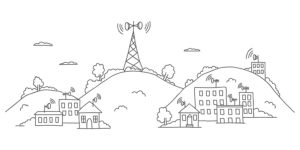This article focuses on the subject of 5G radiation. It is a non-ionizing electromagnetic radiation. Because 5G radiation is small, it doesn't possess the capability of breaking the bonds between chemical molecules in biological tissues or trigger any alteration to cells. It is not known if 5G radiation affects the risk of developing skin cancer. No evidence has been found to suggest that it can cause any other diseases.
Millimeter-wave radiation with high frequency
High-frequency millimeter wave radiation emitted by mobile phones and wireless networks can cause adverse health effects for humans. There are many ways in which this radiation could be harmful. In certain instances the radiation could cause damage to a person's DNA. In other cases, it may cause damage to other areas within the body like the brain.
Recent research has shown that 5G technology can cause the heating of tissues. This is why the International Council on Non-Ionizing Radiation Protection (ICNIRP) has asked for a review of the existing thermal and biological safety standards. The current standards for exposure are not adequate to protect individuals from excessive heating in the event of exposure to millimeter wave pulses.
Skin cancer risk
There is no definitive answer to the question of whether 5G radiation causes skin cancer. It is however believed that 5G RF EMFs behave similar to high-LET ionizing radio waves. In turn, they may cause large amounts of free radicals within the skin. The FCC hasn't issued any specific guidelines about the potential dangers associated with 5G technology. does 5g emit radiation is ongoing.
Although there has been a variety of studies that examine the effects of radio waves that are higher frequency on human health but they've remained restricted in their scope. However, there is 5g radiation symptoms over the effects of millimeter-wavelength exposure on oxidative stress and gene expression. The effects could extend to the skin and other organs, like the brain.
The impact of other illnesses
The latest generation of technology for wireless, called 5G, is rapidly expanding, but scientists are concerned about the potential health risks. The technology will significantly increase the amount of electromagnetic radiation found in our environment. This issue has sparked debates in many countries, including Switzerland. In September 2017 390 doctors and scientists have backed a motion to put a moratorium on 5G deployment. This motion was not heeded by the European Commission, which is responsible for monitoring the use of technology like 5G.
As a result there is a need for more research to assess the health effects of 5G. However, studies have shown that 5G does not cause the same adverse effects on humans as the radiation from older mobile networks. Additionally, it does not transmit an entirely new strain of coronavirus. Furthermore it doesn't make people more susceptible to viral infections.

The measurement of exposure
Monitoring the radiation exposure of 5G is an essential component of ensuring the safety of 5G networks. There are two methods to determine exposure. One method is measuring the power of radio waves absorption by human tissue. The other is measuring the amount of radiofrequency energy released by an object. Radiation frequency energy (RF) can be described as an energy source that comes directly from radio receivers.
In 5g towers radiation United States, the FCC has implemented a limit on the energy density of 5G mobile devices. These tests only determine power density at just several inches, and they do not require measurements of every beam. FCC does not require measurements of every beam. However, it is possible to determine the energy density for each beam can be estimated through computer simulation. The worst case scenario is selected depending on the design of each beam.
Limitations of the study
There's been a lot of discussion over the impact of 5G radiation on the health of people. For instance, the Swiss authorities, for example has issued an assessment that concludes that the technology is not likely to cause health effects in the short term, but there are no studies which have shown long-term effects. However, this report also contains several issues, including biased reportage.
The power and frequency of radio waves that carry energy depend on the frequency. The energy that is carried by a millimetre waves will be identical to the frequency of radio waves currently however, they're less visible and will be better suited for high-density environments, since they will not be obscured by walls or glass. High-density urban areas would require many small, low-power sites, and suburban areas will benefit from 5G stations operating at lower frequencies.
